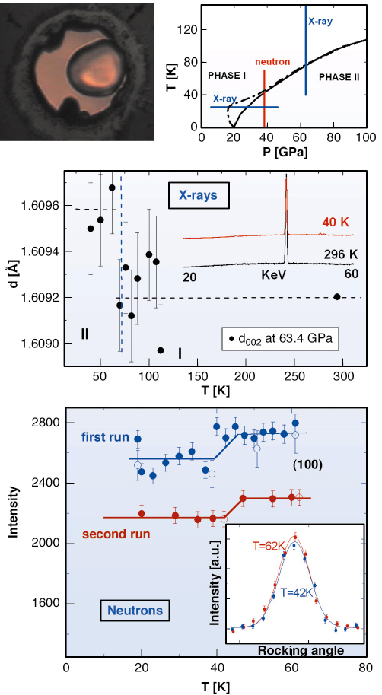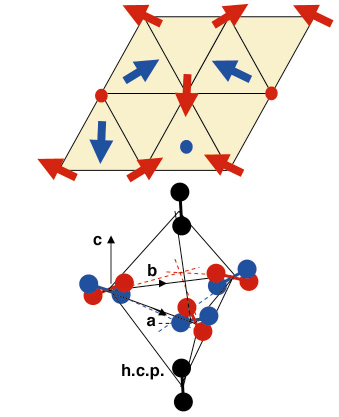- Home
- Users & Science
- Scientific Documentation
- ESRF Highlights
- ESRF Highlights 2005
- Materials Science
- The Broken Symmetry Phase of Solid Deuterium
The Broken Symmetry Phase of Solid Deuterium
The solid hydrogens (H2, D2, HD) are considered essential for the discovery of new quantum many-body effects of density. Numerous calculations of exciting properties of dense hydrogen have been made, such as the recently predicted ‘metal superfluid’ state [1]. However, experimental verification presents technical challenges and often the observed properties are more subtle than predicted. Determination of the structure of phase II of deuterium is a clear illustration of the special status of the solid hydrogens.
From spectroscopic studies, three phases of solid hydrogens have been discovered up to the maximum pressure achieved, 320 GPa. The solid hydrogen compounds D2, HD and H2 remain quantum molecular solids up to the 100 GPa range. A remarkable macroscopic consequence is the existence of a pressure-induced broken symmetry phase (BSP) transition from phase I to phase II, in which the molecules go from a spherical rotational state to an anisotropic rotational state. The high temperature phase I consists of a closed packed hexagonal lattice of freely rotating molecules. Despite many theoretical studies, the nature of phase II remained unknown.
Solid D2 is the isotope for which the BSP transition occurs at the lowest pressure (at T = 4K, 28 GPa for D2, 69 GPa for HD and 110 GPa for H2). However, X-rays are almost insensitive to the individual positions of D atoms in the molecules and to orientational ordering because D2 has no inner electronic shells, and X-rays are scattered by electrons in molecular orbitals. Also, because of the very small scattering power of a hydrogen crystal in a diamond-anvil cell, the use of a third-generation synchrotron source and the growth of a single crystal in helium were previously needed to measure the EOS of D2 to 120 GPa in phase I [2]. This X-ray approach has been extended here to low temperature. Contrarily, neutrons are scattered by individual nuclei, and therefore can be used to determine the individual positions of D in the structure, as well as the orientations of the molecules. Owing to the low intensity of neutron sources, the high pressure neutron study of solid D2 is even more challenging. Consequently, a combination of X-ray and neutron measurements were needed to solve the structure. The X-ray work at beamlines ID9 and ID27 was useful to study the change of the unit cell at the BSP transition, to explore a large domain of P-T and to detect the appearance of a superstructure, to test the reproducibility of the observation on various samples, the effect of strain and to orient the single crystal for the neutron experiment. Four different D2 crystals were studied by X-ray diffraction: two of them embedded in helium pressure transmitting medium. The neutron study was performed on one D2 single crystal in helium at a constant pressure of 38 GPa to measure the change of intensity of the various peaks at the BSP transition.
 |
|
Fig. 38: (a) Single-crystal of D2 in helium; Phase diagram (b) and the P-T paths of the X-ray (c) and neutron measurements (d). The evolution of the 002 d-spacing (X-rays) and the intensity of the 010 reflection (neutrons) show the changes at the I-II phase transition upon cooling. |
The (100), (010), (1-10) (101), 110), (1-10) and (002) reflections were collected in the X-ray and neutron experiments. The Figure 38 presents the precision of both X-ray and neutron data that were achieved. From X-ray measurements, we find that the I-II transition does not affect the diffraction peak of the hcp lattice, except for a very small volume discontinuity (a ![]() V/V= –10-3 is measured). The quality of the crystal at 38 GPa (rocking curve of 1°) allowed an accurate determination of the intensity of the various peaks. The integrated intensity of the various reflections changes very weakly at the transition, in contrast to the more than 20% intensity change for the strongest candidates of the structure of phase II (orthorhombic modifications of the hexagonal phase I). To explain the data, we followed a theoretical prediction that the BSP transition could be purely rotational forming four sublattices with molecular axes directed perpendicular to the four different faces of a tetrahedron. This structure is shown in Figure 39 and it explains most of the intensity changes measured. But this type of local order has a topological frustration when built in a hexagonal lattice. That is resolved in developing an incommensurate long-range order. Indeed, incommensurate reflections are observed in phase II both with X-rays and with neutrons.
V/V= –10-3 is measured). The quality of the crystal at 38 GPa (rocking curve of 1°) allowed an accurate determination of the intensity of the various peaks. The integrated intensity of the various reflections changes very weakly at the transition, in contrast to the more than 20% intensity change for the strongest candidates of the structure of phase II (orthorhombic modifications of the hexagonal phase I). To explain the data, we followed a theoretical prediction that the BSP transition could be purely rotational forming four sublattices with molecular axes directed perpendicular to the four different faces of a tetrahedron. This structure is shown in Figure 39 and it explains most of the intensity changes measured. But this type of local order has a topological frustration when built in a hexagonal lattice. That is resolved in developing an incommensurate long-range order. Indeed, incommensurate reflections are observed in phase II both with X-rays and with neutrons.
 |
|
Fig. 39: Proposed structure for phase II of solid D2. The unit cell is P-3 symmetry, with eight molecules. Arrows point to the positive z-hemisphere, circles depict molecules lying along the c-axis. The molecular axes of the molecules are locally directed towards the centre of a tetrahedron. |
In addition to the resolution of the structure of phase II of solid D2, this work opens new possibilities for high pressure crystallography. Combining the X-ray and neutron structural studies has certainly been used previously to resolve complex structures near ambient pressure. The present work demonstrates that this is now feasible at very high pressure in a diamond anvil cell.
References
[1] E. Babaev, A. Sudbo and N. Ashcroft, Phys. Rev. Lett. 95, 105301 (2005).
[2] P. Loubeyre, R. LeToullec, D. Hausermann, M. Hanfland, R.J. Hemley, H.K. Mao and L.W. Finger, Nature 383, 702 (1996).
Principal Publication and Authors
I. Goncharenko (a), P. Loubeyre (b), Nature 435, 1206 (2005).
(a) Laboratoire Léon Brillouin (France)
(b) Commissariat à l’Energie Atomique (France)



